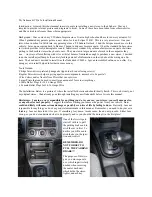
InMail Park and Page
Description
InMail Park and Page can automatically Park a call at an extension and Page the user with a recorded
Paging Message announcing the parked call. The called extension user can then go to any telephone
and implement Personal Park to pick up the call. With InMail Park and Page, InMail tries to locate the
person instead of just sending the call to their mailbox. Additionally, there is no need for an operator or
receptionist to manually answer the call, park it, and then try to track down the employee.
The Paging Message is usually recorded in the user’s own voice and typically says something like,
“Mike Smart, you have a call.” If the Paging Message is not recorded for the extension, a built-in
message announces the called party’s name or extension number (if the name is not recorded).
InMail Park and Page is available for all trunk calls that are redirected to voice mail via forwarding or
overflow, including transferred calls, Direct Inward Lines, and Direct Inward Dialing. Park and Page is
also available for Automated Attendant Screened (STRF) and Unscreened (UTRF) Transfers.
Optionally, an extension can have calls from the Automated Attendant immediately Park and Page
without trying their extension first.
When InMail Park and Page intercepts the call, it normally offers the caller three options:
1.
Dial
1
to leave a message in the called extension’s mailbox.
(The caller hears the mailbox Greeting, if recorded.)
2.
Dial
2
to Park and Page.
(The caller returns to these options if the Park is not picked up.)
3.
Dial
3
for other options.
(Normally, this routes to the extension’s Next Call Routing Mailbox.)
InMail Park and Page is available at Personal and Group Subscriber Mailboxes, and can be enabled
through system programming or via the subscriber’s Mailbox Options Menu. InMail Park and Page is
not applicable to Intercom calls.
Automated Attendant Direct to Voice Mail (DVM)
When an extension has Automated Attendant Direct to Voice Mail (DVM) enabled, all calls from the
Automated Attendant go directly to the subscriber’s mailbox. The extension does not ring for
Automated Attendant calls. The caller hears the mailbox greeting and can leave a message, but unlike
Park and Page is not normally offered any other routing options. A subscriber typically turns on DVM
when they need to work at their desk undisturbed by outside calls from the Automated Attendant.
DVM can be enabled by the installer from system programming or by the extension user from their
Mailbox Options Menu.
Keep in mind that DVM does not block Intercom calls from co-workers or any other outside call not
routed through the Automated Attendant. For example, with DVM enabled, Direct Inward Lines and
transferred outside calls to an extension work normally.
Conditions
• The Park and Page feature uses the extensions personal park location only.
• Enabling Automated Attendant Direct to Voice Mail (DVM) for a mailbox bypasses the Park and
Page feature.
• The Park and Page feature uses the All Zone paging only; this cannot be changed or configured.
ISSUE 2.0
SL1100
Features and Specifications Manual
1-407
I
Summary of Contents for SL1100
Page 2: ......
Page 3: ...Features and Specifications Manual A50 031169 003 NA ISSUE 2 0 ...
Page 171: ...5 Press Speaker key to hang up ISSUE 2 0 SL1100 Features and Specifications Manual 1 159 C ...
Page 218: ...2 Dial 724 SL1100 ISSUE 2 0 1 206 Dial Pad Confirmation Tone D ...
Page 741: ... Direct Inward Dialing DID ISSUE 2 0 SL1100 Features and Specifications Manual 1 729 T ...
Page 856: ...MEMO SL1100 ISSUE 2 0 2 26 Codes Tables ...
Page 862: ...MEMO SL1100 ISSUE 2 0 3 6 Features Availability by Software Revision ...
Page 863: ...MEMO ISSUE 2 0 SL1100 Features and Specifications Manual 3 7 ...
Page 864: ...Features and Specifications Manual NEC Corporation ISSUE 2 0 ...
















































